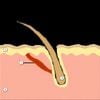Search
forLearn
5 / 28 resultslearn Stem Cell Factor
learn Osteopontin
signaling protein that, when suppressed, may grow hair by reducing inflammation and stem cell loss
learn Stemoxydine
chemical from L'Oreal that encourages hair to enter growth phase
learn Dexpanthenol
precursor of vitamin B5 with hair stimulating effects
Research
5 / 1000+ resultsresearch Mechanism of Action of Isotretinoin
Isotretinoin effectively treats severe acne but can cause significant side effects like dry skin and hair loss.

research The 3D Bioprinted Scaffolds for Wound Healing
3D bioprinting improves wound healing by precisely creating scaffolds with living cells and biomaterials, but faces challenges like resolution and speed.

research Generating Detailed Intercellular Communication Patterns in Psoriasis at the Single-Cell Level Using Social Networking, Pattern Recognition, and Manifold Learning Methods to Optimize Treatment Strategies
New insights into cell communication in psoriasis suggest innovative drug treatments.

research Large-Scale Skin scRNA-Seq Profiling Highlights Distinct Body Site-Specific Ligand-Receptor Interactions and Pathways in Keratinocytes
Different body areas have unique skin cell communication patterns, explaining why certain skin diseases occur in specific regions.

research Telescope Model for Coordinated Organ Morphogenesis and Stem Cell Formation
Developing hair follicles form from ring-shaped patterns, with future stem cells originating from the outer ring, not the upper layers, as previously thought.
Community Join
5 / 1000+ resultscommunity One year on finasteride has reversed some aging
Finasteride and minoxidil use resulted in a more youthful appearance and improved skin. There is debate about their effects on collagen and skin aging, with no solid evidence supporting significant changes due to finasteride.

community Physio-metabolic method of treating androgenic alopecia. Cold receptors. The relationship between DHT, cold receptors, minoxidil and antiandrogens
Treating androgenic alopecia with minoxidil, finasteride, and antiandrogens, alongside exercise, cryotherapy, and natural substances to stimulate cold receptors for better hair growth. The method focuses on enhancing treatment effectiveness by considering environmental and behavioral factors and the role of cold receptors and muscle stress.
community The Worst Hair Loss Condition You (MAY) have: LPP
Lichen Planopilaris (LPP) is an autoimmune condition causing permanent hair loss and fibrosis, often misdiagnosed. Treatments include pioglitazone, topical corticosteroids, anti-inflammatory medication, and Jak inhibitors.
community Verteporfin and Microneedling
Clinical studies by Dr. Barghouthi and Dr. Bloxham indicate that Verteporfin, when used with FUE and FUT hair transplantation methods, shows promise in hair follicle regeneration and minimal scarring due to its ability to inhibit Yes-associated protein (YAP). Microneedling at depths of 3-3.5mm, combined with Verteporfin, could potentially reactivate dormant follicles, although the optimal dosage and application method are still under investigation. Concerns remain about the DHT sensitivity of regenerated follicles, highlighting the need for further research to optimize trauma levels and Verteporfin concentrations to achieve effective and scar-free hair regeneration.
community UVA researchers discovered stem cells that plays a crucial role in hair growth - We are closer than ever to the cure!
Researchers at the University of Virginia discovered a new group of stem cells in hair follicles that could potentially restore hair growth. The findings suggest that activating these stem cells might offer a new way to combat hair loss, though practical treatments are still years away.